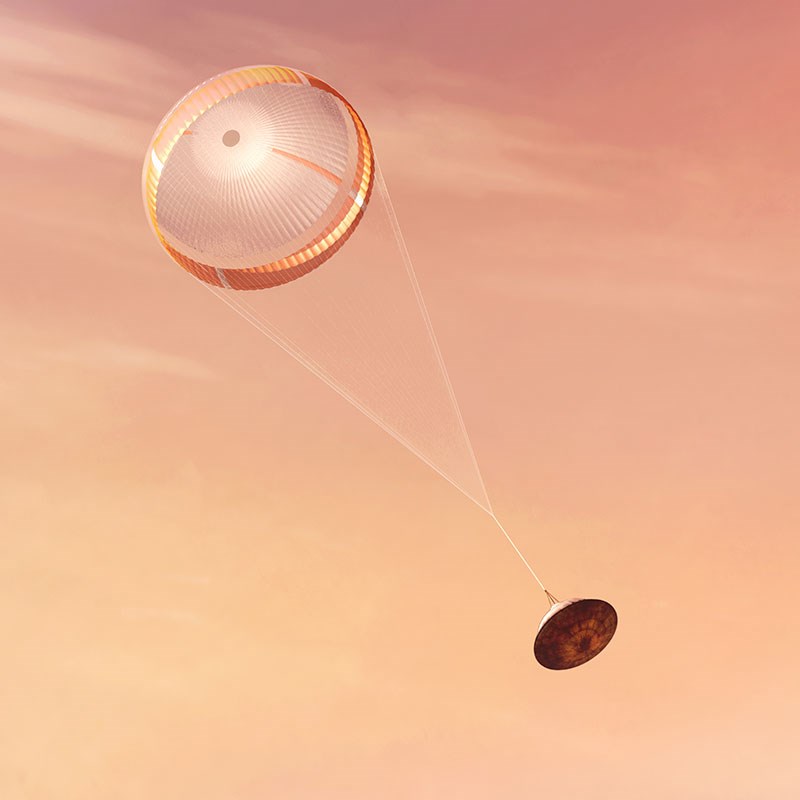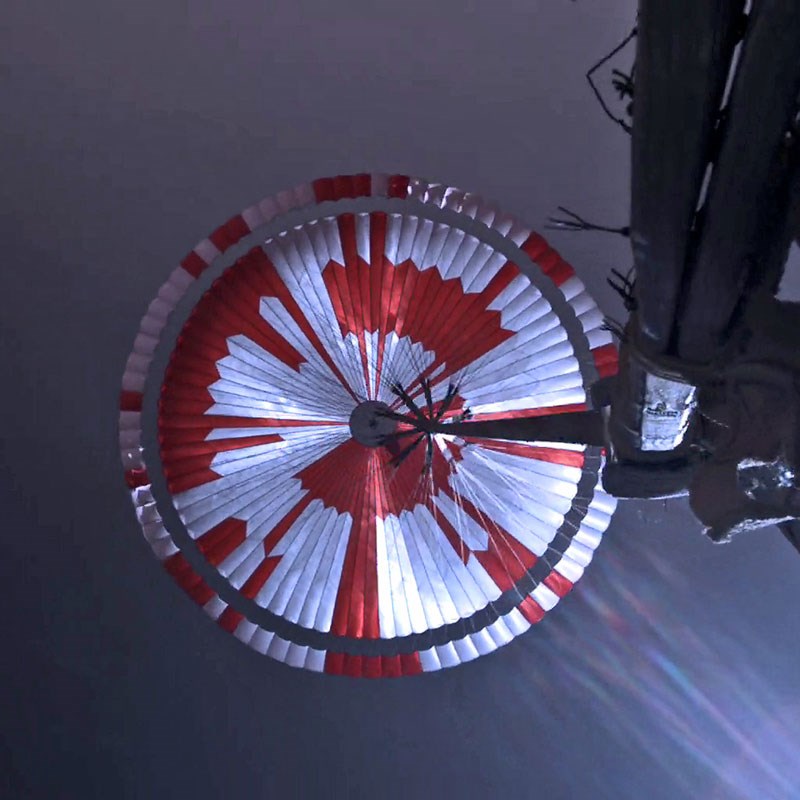Faculty Researchers Help Develop New Parachutes for Landing on Mars and Beyond

11/22/2021
By Madeline Bodin
Seven minutes of terror.
That is how NASA describes the moments between when a Mars rover enters the red planet’s atmosphere and when it safely touches down.
The seven-minute entry, descent and landing constitute the mission’s most intense, challenging and nerve-wracking phase, with the spacecraft decelerating from a speed of 12,500 mph to land gently on a small target on the surface of the planet.
On NASA’s most recent Mars expedition, the seven minutes of terror for the rover named Perseverance began on February 18, 2021, at 3:48 p.m. Eastern Standard Time, when it reached the top of the Martian atmosphere.
Four minutes later, the planet’s thin atmosphere had slowed the rover to about 1,000 mph, still significantly faster than the speed of sound. In an instant, a 70.5-foot-wide parachute snapped open above the one-ton, $2.7 billion robotic explorer.
Minutes later, Perseverance landed safely on Mars’ Jezero Crater, promptly eliciting cheers and sighs of relief from mission controllers back on Earth.
With that milestone achieved, NASA is already preparing for the new challenges of future missions, not only to Mars but to other planets as well. Mechanical Engineering Assoc. Prof. Alireza Amirkhizi and Prof. James Sherwood, dean of the Francis College of Engineering, will contribute to making the descent onto planetary surfaces a little less terrifying through their research, funded by a three-year NASA grant worth nearly $640,000.
The goal of these Early Stage Innovation grants, NASA says, is to “accelerate the development of groundbreaking, high-risk/high-payoff space technologies to support the future space science and exploration needs of NASA, other government agencies, and the commercial space sector.”
Amirkhizi and Sherwood’s research will create a computer model of how parachute canopy fabrics and suspension lines behave during deployment, inflation and descent. This model will help guide parachute designers, no matter what kind of planetary atmosphere or what kind of payload may be involved in future missions.
A thin atmosphere means that a parachute needs a bigger surface area to provide the same braking power it would have on Earth. Extra weight means extra cost, which is magnified by the distance that a spacecraft needs to travel. (To reach Mars, Perseverance had to travel about 293 million miles.) The engineering challenges and cost are quite significant.
“One would want to minimize any redundant weight, but you don’t want to risk a disaster with a parachute failing to deploy,” says Amirkhizi. “Failure is not an option.”
Amirkhizi, who is the principal investigator for the project, says the broad challenge “is modeling a substantial number of multiphysical events.”
The principle behind the work is fluid-structure interaction (FSI) modeling, in which the fluid represents a planet’s gaseous atmosphere. Researchers at Stanford University and the University of Illinois at Urbana-Champaign will focus on the “fluid” portion of the model under separate NASA grants, while UMass Lowell researchers will focus on the “structure” part.
“The canopy fabric, suspension lines and various other components, which constitute the structure of the parachute, are solid objects, generally textiles, interacting with the fluid flow in a very complex manner,” Amirkhizi explains.
“While the parachute is a solid, it’s a flexible solid, so it’s more challenging to model. It’s also a somewhat permeable solid. The fluid not only flows around the canopy and suspension lines, but also flows through the canopy.”
Existing treatments of the structural elements in the FSI models being used now are not accurate enough for what
NASA and its collaborators hope to accomplish in the future, he notes.
Suited for Experimentation
Things move fast in Amirkhizi’s lab. That is one of the reasons UMass Lowell is well-suited for this research, which will include lab-scale experimental characterization, Amirkhizi says.
“In my lab, we look at dynamic behavior of materials, which means how materials react to loadings that happen at much faster than normal speeds,” he says. For example, his lab has worked in the past to test the crashworthiness of various materials, including composites, fabrics and polymers.
One of the devices used in these tests is a specialized gas gun, which allows materials to be evaluated at high velocities. “It’s not what you might find in other labs,” Amirkhizi says. But, with some adjustments, it is exactly what is needed to conduct the parachute research.

“These are not simple push-pull forces, but are loadings, or excitations, in different directions at the same time. Most materials act differently under these conditions because they are designed to work in one direction, and if you push or pull them in another direction, they break down faster,” he says.
It is a focus that is particularly important for the parachute project, Amirkhizi adds.
While the equipment used is highly specialized, it blends in with the other equipment found in the college’s labs because the experiments are done at a moderate scale. Amirkhizi says that the size of the materials in his experiments are generally no larger than a square foot.
Sherwood, the co-principal investigator for the NASA grant, is an expert on composite materials and has worked extensively on the modeling and experimental investigation of baseball bat and ball impacts for Major League Baseball and the NCAA. He will also bring experience with parachute canopy suspension lines to the project, based on his prior research.
Perseverance’s parachute was able to bring the rover safely to the Martian surface, but it burst into popular culture for another reason. Coded into the white and red parachute gores, or strips, that made up its canopy was the message, “Dare mighty things.”
The daring space missions of the future could rely on the models being created at UMass Lowell today.
“These models will predict events such as the deployment, inflation and descent of the parachute that will happen about a year or more after the spacecraft’s launch and many millions of miles away from mission control,” Amirkhizi says. “These models are critical to making sure that the mission is cost-effective and successful.”
